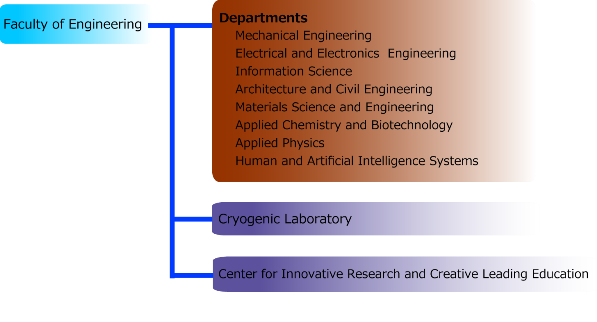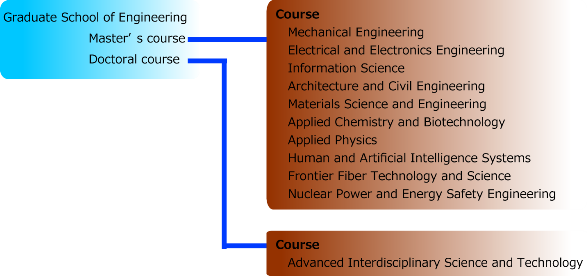Overview
Outline
The Faculty of Engineering consists of eight departments, offering well-developed educational systems that cover almost all fields of engineering. The Faculty is one of the largest in Japan, with an enrollment limit of 555 students, including 525 for regular enrollment and 30 for junior-year transfer students. In 2006, we opened Center for Innovative Research and Creative Leading Education (CIRCLE), aiming for enhancing education to foster creativity and collaboration with regional communities. In our Graduate School, the Fiber Amenity Engineering Course was established in 2002, the Human and Artificial Intelligence Systems Course in 2003, and the Nuclear Power and Energy Safety Engineering Course in 2004. We now have ten master’s courses (total enrollment limit: 239). In 2006, we launched a doctoral course for the Nuclear Power and Energy Safety Engineering Course, and the total number of doctoral courses increased to four (total enrollment limit: 40).
Our school of engineering is functioning as a leading-edge institution for education and research on science and technology. In our university, we have internationally-renowned research facilities, such as the Research Center for Development of Far-Infrared Region (FIR FU). The Headquarters for Innovative Society-Academia Cooperation promotes the entrepreneurship education as well as the collaborative research with communities and industries.
Undergraduate School

Graduate School

Brief History of Our School
- 1949
- Under a new educational system in Japan introduced after World War II, Fukui Teachers’ School (founded in 1873) and Fukui Technical College (founded in 1923) were united to form Fukui University, with two faculties, Education and Engineering. At that time, the Faculty of Engineering consists of only three departments.
- Up to 1988
- The Faculty of Engineering experienced reorganization several times to meet the needs of the times, and the number of departments increased to 11 in the undergraduate school, and 11 master’s courses for the graduate school.
- 1988 to 1989
- The number of departments decreased to seven, due to the unification of several departments to form larger departments to cover a wider range of disciplines.
- 1993
- Doctoral courses were established in the Graduate School of Engineering: seven master’s courses and two doctoral courses.
- 1999
- The Faculty of Engineering was reorganized into an eight-department system as a result of university reform.
- 2002
- Master’s and Doctoral courses of the Fiber Amenity Engineering were established. These courses are independent courses without having corresponding undergraduate departments. In 2003, the Graduate School of Engineering consisted of eight master’s courses, one independent course (Fiber Amenity Engineering), and three doctoral courses.
- 2004
- A new independent master’s course, the Atomic Power and Energy Safety Engineering Course was established.
- 2006
- The doctoral course for the Atomic Power and Energy Safety Engineering was commenced.
